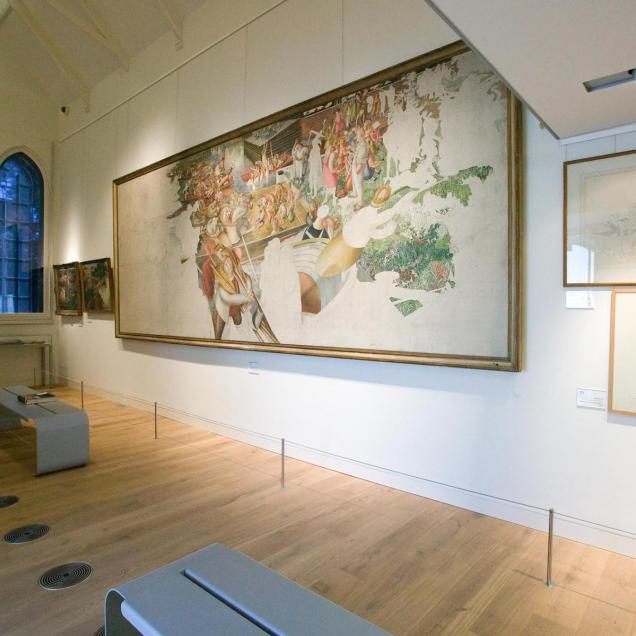

A relatively small investment has made a vibrant gallery run entirely by volunteers an even better place to visit, says Caroline Worthington
The name of Stanley Spencer conjures up vivid images of Christ returning to Cookham (or "the holy suburb of heaven" as he called the village on the Thames where he was born and lived), as well as the artist’s unconventional private life and eccentric image. Fellow villagers would often see him pushing a canvas and easel in an old pram while wearing his pyjamas under his clothes when it was chilly.
Spencer, a devout if idiosyncratic believer regularly worshipped in the village's tiny Methodist chapel in the High Street, a few doors from his own house. Converted into the Stanley Spencer Gallery three years after his death in 1962, the chapel has recently reopened after a year-long refurbishment. It is a striking transformation, yet at the same time as homely as a Resurrection scene painted by the artist.
The gallery is run entirely by volunteers - many of whom can remember Spencer painting the village, its Churchyard, back gardens, and surrounding meadows. Friends of the gallery who might have worried that it could lose its charm along with the dark brown hessian walls and large plan chests that once cluttered the nave can relax. The architects and designers have risen to the challenge of lifting the gloom and creating modern gallery space within a modest Victorian building. It’s clean, fresh and simple, just about retaining the intimacy if not the interior of the chapel.
Keeping it local
You receive a warm welcome at the new reception desk, which doubles up as a shop counter. As you turn you are greeted by Spencer himself, or rather a self portrait as a young man, not the white haired “divine fool��? of later years. Beyond, visitors find that the gallery now extends over two floors thanks to a new mezzanine reached by a simple glass and steel staircase or via a lift.
Halfway up the stairs is the perfect spot to view Spencer's last great work unfinished at his death. Christ Preaching at Cookham Regatta is so large that it must have been difficult to see it properly before. Now it is easy to imagine that you are standing on the bridge looking down on the regatta that Spencer remembered from his childhood. Typically, Christ is surrounded by Cookham residents - Mr Brooks, the ferryman, and others wearing their holiday best.
Spencer referred to the chapel as "that sacred space", a phrase borrowed for the title of the first exhibition, which includes many pieces lent by private collectors. There are images made when he was an official war artist, landscapes as well as a selection of drawings. Downstairs, works are unglazed, with low-level barriers to deter sticky fingers.
There are display cases with the personalia you might expect in an artist's museum: Spencer's spectacles, his well-thumbed Bible, as well as pencils and palette. If anything more could be made of this material linking it to the way Spencer worked. He would paint with small brushes, his nose pressed close to the canvas. There are plenty of photographs that could accompany them, which feature on the gallery's excellent website.
Those visitors making the most of a day out in Berkshire can follow in Spencer's footsteps beyond the former chapel, taking a walking tour around Cookham. Led by a volunteer or downloaded from the gallery's website, the tour links specific works with the local landscape.
A spring in its step
Upstairs the works are glazed, so the low barriers found are unnecessary. Drawings such as The Chemist and The Garage Proprietor feature Spencer's neighbours. Biographical details can be gleaned from the catalogue costing the princely sum of 50p. Apparently, the chemist liked to receive his daily newspaper via his bedroom window by pulling it up on a string. One day the newspaper boy attached a kipper. The garage was run by a former pilot, ex-Royal Flying Corps, who got his adrenaline fix racing cars up and down the High Street.
Spencer's own unconventional private life was no doubt the talk of the village. The painter laid it bare in the Marriage at Cana. Conceived three years after his first wife's death, it refers to the unrealised re-marriage he had hoped for following their divorce and his second, shortlived marriage to Patricia Preece.
It is tempting to say that the gallery has risen from the dead, but that would be unfair. It might have been a bit sleepy, but was never asleep. Its volunteers and friends are far too dedicated to let that happen. But the £882,000 cash injection from the Heritage Lottery Fund, modest by many standards, means the gallery has a new spring in its step – as well as a new logo.
The automatic front doors, which open and close of their own accord, are the only noticeable things on the snagging list. The comments book is full of admiration from visitors who have traveled from as far afield as California and Germany. “Just how Spencer would have liked this building" wrote one person, which says it aIl.
Caroline Worthington is the curator of art at York Museums Trust
Project data
Cost £981,000
Main funder Heritage Lottery Fund £882,000
Architect Pringle Richards Sharratt
Project Management Clarkson Alliance
© Museums Journal Review 2007